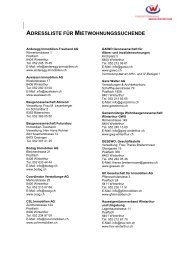Handbook for Investors. Business location in Switzerland.
Handbook for Investors. Business location in Switzerland.
Handbook for Investors. Business location in Switzerland.
You also want an ePaper? Increase the reach of your titles
YUMPU automatically turns print PDFs into web optimized ePapers that Google loves.
Sole proprietorship and general partnership<br />
www.kmu.adm<strong>in</strong>.ch<br />
Languages: German, French, Italian<br />
5.1.6 Jo<strong>in</strong>t venture<br />
The jo<strong>in</strong>t venture is becom<strong>in</strong>g more and more important as a <strong>for</strong>m<br />
of partnership. It is not regulated by law and is an appropriate<br />
<strong>for</strong>m <strong>for</strong> a jo<strong>in</strong>t activity with a Swiss partner. A jo<strong>in</strong>t venture is often<br />
operated as a jo<strong>in</strong>t <strong>in</strong>vestment <strong>in</strong> a newly <strong>for</strong>med corporation<br />
(a <strong>for</strong>eign supplier, <strong>for</strong> example, establishes a manufactur<strong>in</strong>g or<br />
sales company together with the Swiss seller). Jo<strong>in</strong>t ventures can<br />
also be operated as an ord<strong>in</strong>ary partnership <strong>in</strong> the case of small<br />
projects (e.g. a research project <strong>for</strong> a limited time period).<br />
5.1.7 Ord<strong>in</strong>ary partnership<br />
The ord<strong>in</strong>ary partnership is a contractual association of several<br />
<strong>in</strong>dividuals or legal entities <strong>for</strong> a bus<strong>in</strong>ess purpose that is not<br />
required to be entered <strong>in</strong> the commercial register. Anonymity is<br />
preserved but each partner is jo<strong>in</strong>tly and personally liable <strong>for</strong> the<br />
jo<strong>in</strong>t project.<br />
Ord<strong>in</strong>ary partnership<br />
www.kmu.adm<strong>in</strong>.ch<br />
Search <strong>for</strong>: E<strong>in</strong>fache Gesellschaft<br />
Languages: German, French, Italian<br />
5.2 Account<strong>in</strong>g.<br />
The general account<strong>in</strong>g regulations <strong>in</strong> <strong>Switzerland</strong> are brief and to<br />
the po<strong>in</strong>t. The accounts required <strong>for</strong> the type and scope of bus<strong>in</strong>ess<br />
must be kept <strong>in</strong> an orderly manner and allow identification of<br />
bus<strong>in</strong>ess assets and of receivables and payables associated with<br />
bus<strong>in</strong>ess operations as well as operat<strong>in</strong>g results (profit or loss) <strong>in</strong><br />
each bus<strong>in</strong>ess year. The law requires that the <strong>in</strong>come statement<br />
(profit and loss account) and the balance sheet be drawn up annually<br />
accord<strong>in</strong>g to generally accepted account<strong>in</strong>g pr<strong>in</strong>ciples and<br />
that they be complete, clear and easily understood. This means<br />
that the account<strong>in</strong>g system can be based on any <strong>in</strong>ternationally<br />
accepted standards (such as US-GAAP, IAS or FER).<br />
Corporations (AGs) must meet detailed m<strong>in</strong>imum requirements<br />
concern<strong>in</strong>g the structure of f<strong>in</strong>ancial statements <strong>in</strong> order to<br />
<strong>in</strong>crease transparency. The annual f<strong>in</strong>ancial statements must<br />
<strong>in</strong>clude, as a m<strong>in</strong>imum, a balance sheet and an <strong>in</strong>come statement<br />
with prior-year comparisons and explanatory notes. The annual<br />
f<strong>in</strong>ancial statements of subsidiaries, <strong>in</strong>clud<strong>in</strong>g <strong>in</strong> particular those<br />
of listed companies, must be consolidated <strong>in</strong> a s<strong>in</strong>gle set of group<br />
f<strong>in</strong>ancial statements if two of the follow<strong>in</strong>g measures are reached<br />
<strong>in</strong> two successive fiscal years:<br />
• Total assets of CHF 10 million<br />
• Annual sales of CHF 20 million<br />
• An average headcount over the year of 200 employees<br />
5.3 Audit<strong>in</strong>g.<br />
Annual f<strong>in</strong>ancial statements are audited <strong>for</strong> correctness and accuracy<br />
by <strong>in</strong>dependent auditors. A legal entity (fiduciary company<br />
or audit association) may also serve as auditor. It must have the<br />
proper qualifications and be <strong>in</strong>dependent. Under new legislation,<br />
the duty to have accounts audited depends on the size and<br />
economic importance of the corporation (AG) or limited liability<br />
company (GmbH). Regular audits apply to companies that are<br />
required to prepare consolidated f<strong>in</strong>ancial statements and also<br />
to companies listed on the stock exchange or if two of the three<br />
measures below are reached <strong>in</strong> two successive fiscal years:<br />
• Total assets of CHF 10 million<br />
• Annual sales of CHF 20 million<br />
• An average headcount over the year of 50 employees or more<br />
If these conditions are not met, then the annual f<strong>in</strong>ancial statements<br />
are only subject to a limited audit (question<strong>in</strong>g of management,<br />
appropriate detailed checks, analytical audit procedures,<br />
etc.). The audit may also be dispensed with entirely, subject to the<br />
approval of the shareholders, if the company has no more than an<br />
average of ten full-time positions over the year.<br />
Statutory audit requirement<br />
www.kmu.adm<strong>in</strong>.ch<br />
Languages: German, French, Italian<br />
<strong>Handbook</strong> <strong>for</strong> <strong>Investors</strong> 2010<br />
45









